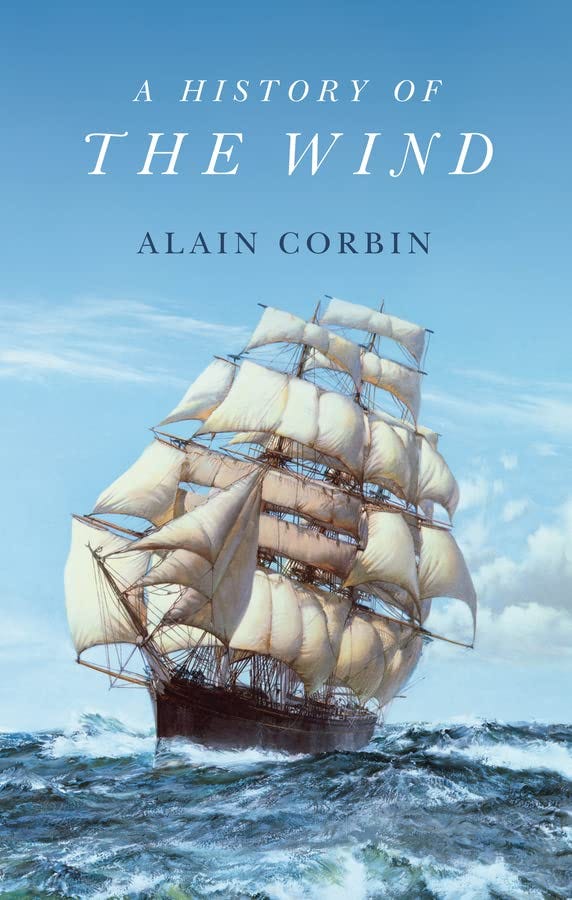Alain Corbin by Nicholson Baker, after a photo by Philippe Dobrowolska
Alain Corbin, born 1936, has written histories of smells, of church bells, of prostitution, of the seaside, and of silence. His new book, which came out in France in 2021 under the title La Rafale et le Zephyr (“The Gust and the Zephyr”) is now published in an unruffled English translation by Williiam Peniston. Here are some passages from Corbin’s A History of the Wind that caught my eye:
From the Prelude:
In the nineteenth century, scientists began to understand the wind. Before then, this noisy emptiness was experienced and described only according to the sensations that it provoked. Inconsistency, instability, and imperceptibility defined this invisible, constant, and unseen flow.
On the winds in The Odyssey:
There are four of them—as there are in the Bible—and each one possesses its own name: Boreas, Notus, Eurus, and Zephyrus. Each one harbors its own form of violence, its own kind of sensory characteristics, from auditory to tactile. They are, in short, beings—obviously obedient ones—each with its own personality
On the Aeolian harp:
Most often, it is a box with a resonance chamber over which strings of different kinds of materials are stretched all along its length. They can be adjusted to produce this or that sound, but, in view of the variations of speed of the wind, the frequency of the vibrations varies and so does the sound that it produces. In a word, the wind becomes the instrumentalist.
On early balloonists:
Lost in this ocean of air, without landmarks, the balloonist allowed himself to be dominated completely by the air. He felt adrift, at the mercy of the winds, from which came an impression of tranquillity and peacefulness, accompanied by a silence that was at times perceived as holy.
Quoting Flaubert's description of an Egyptian khamsin, or sand storm:
“A second dust-spout comes on us. This one advances like the smoke from a conflagration, suet-colored, with jet-black tones at the base. It comes … and comes … and the curtain is on us, bulging out in volutes below, with deep black fringes. We are enveloped by it: the force of the wind is such that we have to clutch our saddles to stay on. When the worst of the storm has passed, there comes a hail of small pebbles carried by the wind: the camels turn their tails to it, stop, and lie down.”
Quoting Victor Hugo, in a moment of irritation at the wind:
“Why this whistling, always the same? Why this creaking, always the same? What good does it do to shout oneself hoarse in the clouds, always repeating the same things? Please change your exclamations."
Nicholson Baker’s most recent book is Finding a Likeness: How I Got Somewhat Better at Art. See his drawings for Book Post at the tag “N Baker Drawing.”
Alain Corbin, color version
Book Post is a by-subscription book review service, bringing snack-sized book reviews by distinguished and engaging writers direct to your in-box, as well as free posts from time to time to those who follow us. Book Sketch with Nicholson Baker is a new special feature for subscribers. Thank you for your subscription! Your support supports our writers and our effort to build a common reading culture across a fractured media landscape. Please help us to grow our audience by giving Book Post to a friend or cheering us on social media.
The book discovery app Tertulia is Book Post’s Winter 2022 partner bookseller. Book Post subscribers are eligible for a free three-month membership in Tertulia, sign up here.
We partner with booksellers to link to their books and support their work, and bring you news of local book life as it happens across the land. Book Post receives a small commission when you buy a book from Tertulia through one of our posts.
Follow us: Facebook, Twitter, Instagram
If you liked this piece, please share and tell the author with a “like.”






